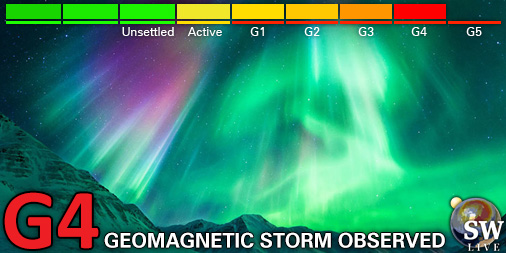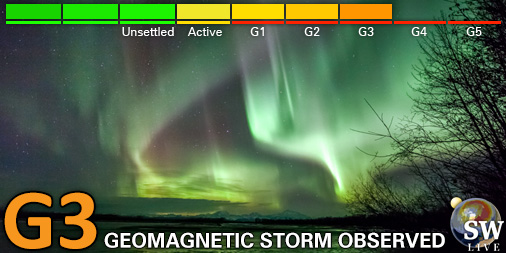Viewing archive of Sunday, 26 October 2003
Solar activity report
Any mentioned solar flare in this report has a scaling factor applied by the Space Weather Prediction Center (SWPC). Because of the SWPC scaling factor, solar flares are reported as 42% smaller than for the science quality data. The scaling factor has been removed from our archived solar flare data to reflect the true physical units.
Report of Solar-Geophysical Activity 2003 Oct 26 2200 UTCPrepared by the NOAA © SWPC and processed by SpaceWeatherLive.com
Joint USAF/NOAA Report of Solar and Geophysical Activity
SDF Number 299 Issued at 2200Z on 26 Oct 2003IA. Analysis of Solar Active Regions and Activity from 25-2100Z to 26-2100Z
Solar activity has been high. Region 486 (S15E31)
produced a long-duration X1.2/3n at 26/0654 UTC, with associated
Type II and IV radio sweeps and a partial-halo CME observed on LASCO
imagery with an estimated speed of 1245 km/s. Region 484 (N03W41)
produced a long-duration X1.2/2n at 26/1819 UTC with an associated
Type II radio sweep and a partial-halo CME observed on Mauna Loa
coronameter imagery. The rise in X-ray flux for this flare was
observed at 1721, and 10 MeV proton flux began to rise at the ACE
spacecraft at 1750 UTC. The greater than 10 MeV proton flux at
geosynchronous orbit reached 10 pfu at 1825 and peaked at 332 pfu at
2020 UTC. An 18-degree filament erupted around S18W51 at 0346 UTC,
and a 12-degree filament erupted at N00W55 at 0331 UTC. Both
erupting filaments were observed on EIT imagery, and their
respective CMEs were observed on LASCO imagery. Neither CME appears
to be earth-directed. Regions 484 and 486 maintained their magnetic
complexity, although Region 484 decayed slightly in size. The 10.7
cm flux value was flare-enhanced and is estimated due to solar
activity at the time of the observation.
IB. Solar Activity Forecast
Solar activity is expected to be high.
Regions 484 and 486 are expected to produce C- and M-class flares,
and X-class flares are possible.
IIA. Geophysical Activity Summary 25-2100Z to 26-2100Z
The geomagnetic field has been quiet to active.
IIB. Geophysical Activity Forecast
The geomagnetic field is
expected to be quiet to active all three days, with possible minor
and isolated major storm conditions on days two and three due to
partial halo CMEs from both X flares observed today.
III. Event Probabilities 27 Oct to 29 Oct
| Class M | 90% | 90% | 90% |
| Class X | 50% | 50% | 50% |
| Proton | 25% | 25% | 25% |
| PCAF | in progress | ||
IV. Penticton 10.7 cm Flux
Observed 26 Oct 298 Predicted 27 Oct-29 Oct 200/200/170 90 Day Mean 26 Oct 121
V. Geomagnetic A Indices
Observed Afr/Ap 25 Oct 010/014 Estimated Afr/Ap 26 Oct 008/015 Predicted Afr/Ap 27 Oct-29 Oct 010/015-015/020-015/015
VI. Geomagnetic Activity Probabilities 27 Oct to 29 Oct
| A. Middle Latitudes | |||
|---|---|---|---|
| Active | 25% | 35% | 35% |
| Minor storm | 20% | 25% | 30% |
| Major-severe storm | 05% | 15% | 25% |
| B. High Latitudes | |||
|---|---|---|---|
| Active | 30% | 35% | 30% |
| Minor storm | 25% | 40% | 45% |
| Major-severe storm | 20% | 30% | 30% |
All times in UTC
Latest news
Latest forum messages
2025/04/12-13 Filament CMEs 2025/04/16 G3 Watch 481Coronal holes 52AR4062 37Filaments and prominences 69AR4064 9
More topicsSupport SpaceWeatherLive.com!
A lot of people come to SpaceWeatherLive to follow the Sun's activity or if there is aurora to be seen, but with more traffic comes higher server costs. Consider a donation if you enjoy SpaceWeatherLive so we can keep the website online!

Latest alerts
Wednesday, 16 April 2025
21:45 UTC - Geomagnetic activity
Minor G1 geomagnetic storm (Kp5) Threshold Reached: 21:36 UTC
21:00 UTC - Geomagnetic activity
Severe G4 geomagnetic storm (Kp8) Threshold Reached: 20:55 UTC
19:45 UTC - Geomagnetic activity
Strong G3 geomagnetic storm (Kp7) Threshold Reached: 19:25 UTC
19:00 UTC - Geomagnetic activity
Moderate G2 geomagnetic storm (Kp6) Threshold Reached: 18:38 UTC
18:45 UTC - Geomagnetic activity
Minor G1 geomagnetic storm (Kp5) Threshold Reached: 18:28 UTC
Space weather facts
| Last X-flare | 2025/03/28 | X1.1 |
| Last M-flare | 2025/04/15 | M1.2 |
| Last geomagnetic storm | 2025/04/16 | Kp8- (G4) |
| Spotless days | |
|---|---|
| Last spotless day | 2022/06/08 |
| Monthly mean Sunspot Number | |
|---|---|
| March 2025 | 134.2 -20.4 |
| April 2025 | 120.7 -13.5 |
| Last 30 days | 120.8 -19.6 |







